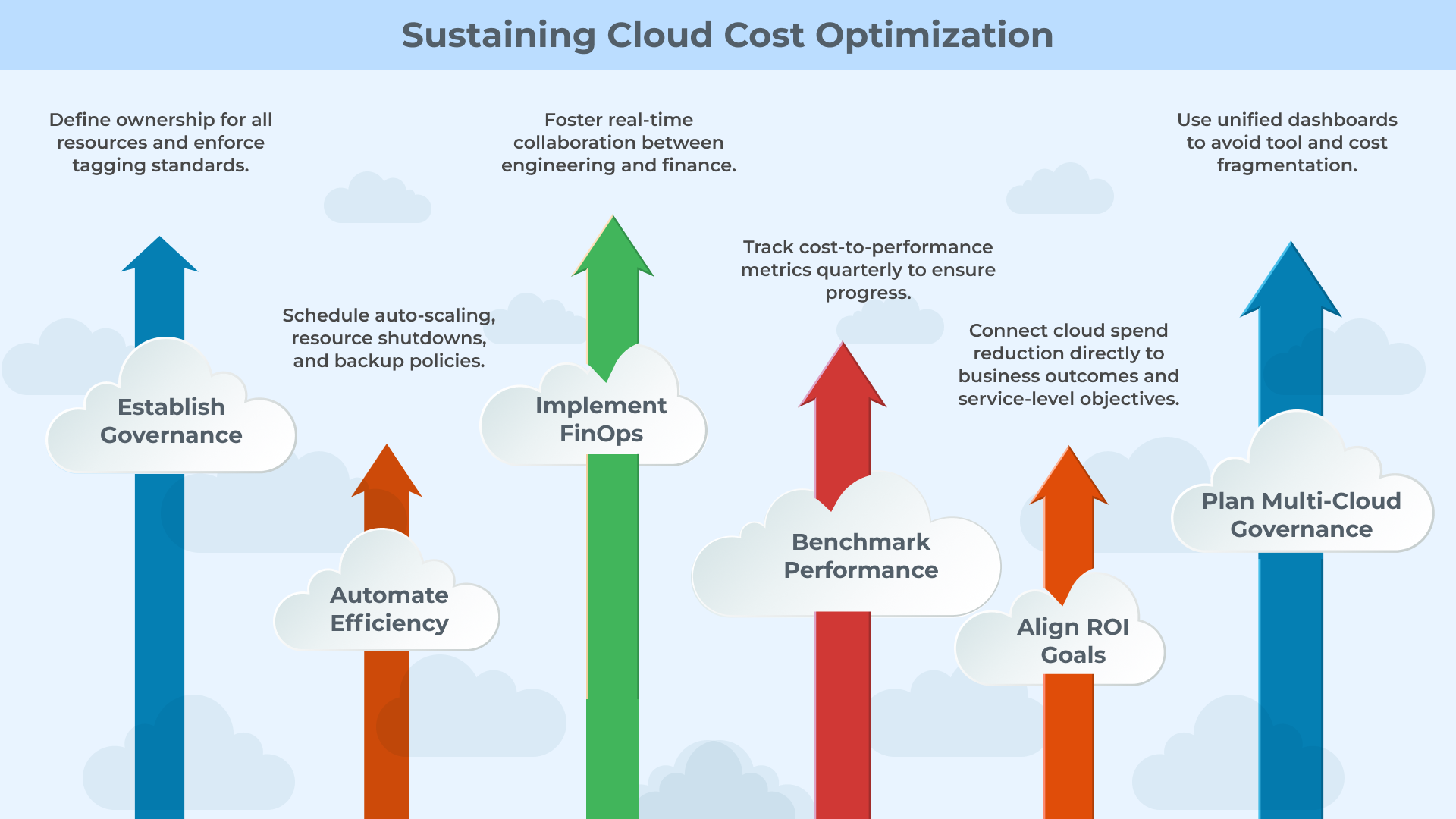
Cloud Cost Optimization: Getting the Most Out of AWS, Azure, and GCP
Cloud computing has refined how many enterprises deploy, scale, and maintain their software. But as the convenience slowly grows, the cost rises, on the other hand. In initial phases of adoption, cloud spend is seen as an acceptable byproduct of agility. With time, however, the time we spend quietly balloons, hidden behind resource sprawl, overlapping subscriptions, and untraced data transfers.
As per the latest 2025 report conducted by Flexra State of the Cloud, 84% of respondents believe that managing cloud spend is the top cloud challenge for organizations today. Many organizations are identifying that scaling cloud infrastructure without strong financial governance can distort margins faster than it drives innovation.
Cloud optimization isn’t just an engineering concern; it’s a complete C-suite priority. The real objective is how it aligns with the Cloud App Development efforts with measurable business outcomes, making sure that every dollar spent directly helps support growth, performance, and innovation.
Technical Cost Optimization Practices
The basic foundation of optimization is to understand the utilization. Once the team gains strong visibility into idle or oversized resources, they can strategically apply the right measures to the right-size infrastructure and could potentially reduce a lot of waste.
-
Right-Sizing and Auto-Scaling
AWS Compute Optimizer, Azure Advisor, and GCP Recommender provide cost and performance recommendations that are based on usage trends. Adopting AWS Auto Scaling Groups or Azure Virtual Machine Scale Sets enables workloads to adjust them to demand, a simple but impactful cost lever. Many businesses have reported seeing a major 20-40% savings on total spending right after implementing right-sizing policies in production environments.
-
Leveraging Reserved and Spot Instances
AWS Savings Plans, Azure Reserved Instances, and GCP offer certain discounts to cut costs significantly for predictable workloads. For temporary or fault-tolerant jobs, Spot Instances or Preemptible VMs can reduce compute expense over time, which in the long run is ideal for the large-scale analytics or machine learning training pipelines.
-
Storage and Data Lifecycle Management
Storage becomes one of the hidden costs that sinks. Solutions such as Amazon S3 Intelligent-Tiering, Azure Blob Storage tiers, and GCP Coldline Storage automatically move less-frequent data to cheaper layers. Combined with data retention policies, it helps the team avoid paying for data that no one ever uses.
-
Serverless and Container Optimization
An additional frequently missed option for tuning performance in the cloud is leveraging serverless architectures. AWS Lambda, Azure Functions, and Google Cloud Run are examples of services that allow you to only pay for execution time instead of having to provision servers that sit idle. Also, optimizing workloads that use containers with properly sized Kubernetes clusters and autoscaling of node pools continues to improve resource utilization while keeping performance in check.
-
Cloud Operations Best Practices
Incorporating Cloud Operations with the best practices, such as automated cost notifications, usage tagging, and policy-based shutdowns, ensures that there’s continuous governance. When acted on correctly, these operational standards can actually transform cloud efficiency from a reactive task into a proactive discipline.
Monitoring & Tooling
Optimizing without proper monitoring is like driving without a dashboard. AWS Cost Explorer, Azure Cost Management + Billing, and GCP Cloud Billing Reports remain the core visibility tools for most enterprises. Regardless, multi-cloud environments need consolidated intelligence, platforms such as CloudHealth by VMware, Spot.io, or FinOut, unify usage data, and assess a complete picture of cost, consumption, and ROI across providers. Building a culture of FinOps is equally important. FinOps (Financial Operations) is not a tool but rather a collective mindset – a combination of finance, engineering, and product management. With FinOps, spending decisions are more transparent, and CTOs and CFOs can work together using live data instead of relying on quarterly reports.
Multi-Cloud vs Single Cloud
Deciding between single-cloud and multi-cloud architecture defines the flexibility and your financial complexity.
Single Cloud:
- Simplifies governance and standardizes tooling.
- Offers deeper service integration (e.g., AWS Lambda + DynamoDB or Azure Synapse + Power BI).
- Easier to secure and monitor at scale.
Multi-Cloud:
- Prevents vendor lock-in and allows selective adoption of best-in-class services.
- Enhances resilience through workload distribution across providers.
- Demands strong multi-cloud optimization strategies, unified identity management, and cost aggregation tools to maintain visibility.
For most entrepreneurs, a hybrid model that uses one core cloud for the Cloud app development and others for special use cases, offers an optimal balance between agility and control.
Case Example: Real Optimization in Action
A SaaS analytics company operating across AWS and GCP once struggled with ungoverned resource usage. Their estimated bill was $420,000 due to underutilised EC2 clusters and duplicated datasets.
Right after implementing auto-scaling, reserved instance commitments, and S3 lifecycle management, the organisation got to know that:
- 35% compute cost reduction
- 22% storage cost savings
- 18% performance improvement through active cloud performance tuning.
Above cost, these actions improved reliability and time-to-market, driving some of the measurable cloud migration ROI that resonates with technical and financial stakeholders.
Checklist for CTOs: Sustaining Cloud Cost Optimization

-
Establish Governance
Define ownership for all resources and enforce tagging standards.
-
Automate Efficiency
Schedule auto-scaling, resource shutdowns, and backup policies.
-
Implement FinOps
Foster real-time collaboration between engineering and finance.
-
Benchmark Performance
Use unified dashboards to avoid tool and cost fragmentation.
-
Align ROI Goals
Connect cloud spend reduction directly to business outcomes and service-level objectives.
Conclusion
Sustainable cloud transformation is a matter of precision, not scale; in fact, as organizations evolve in their digital ecosystems, cloud cost optimization becomes a foundational element of operational resilience, allowing organizations to support true innovation without diminishing their efficiency. We at Telliant Systems leverage Cloud Operations best practices throughout the Cloud App Development process. We start utilizing these best practices during architectural design and retain them during performance monitoring.
We utilize automation, governance, and multi-cloud optimization, while enabling teams to understand ROI from cloud migrations as an organization, all while retaining performance, security, and scalability built into their systems. In today’s world, the true measure of cloud maturity is innovation that is cost-effective, and performance based.






































